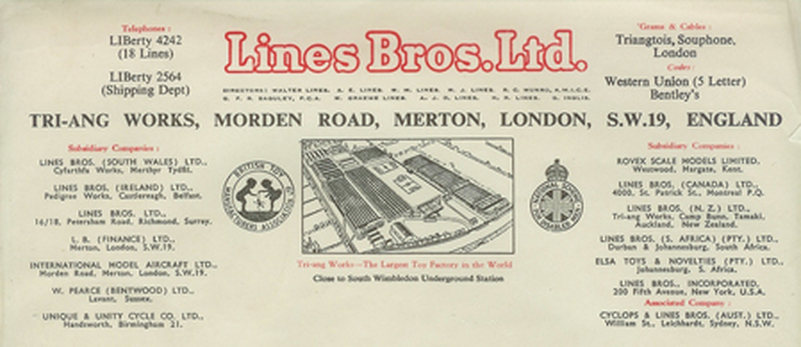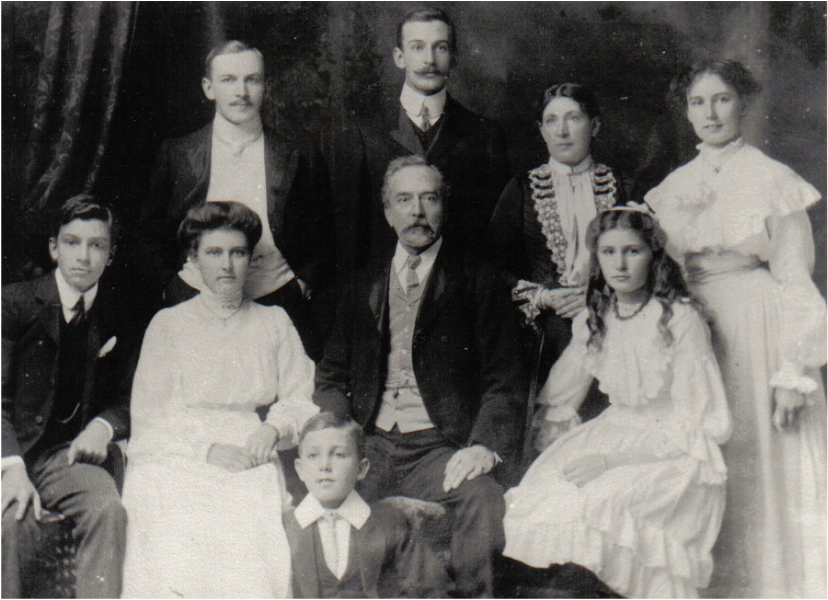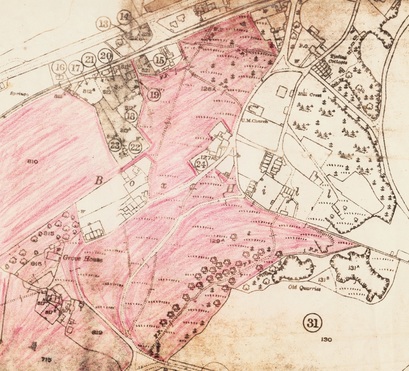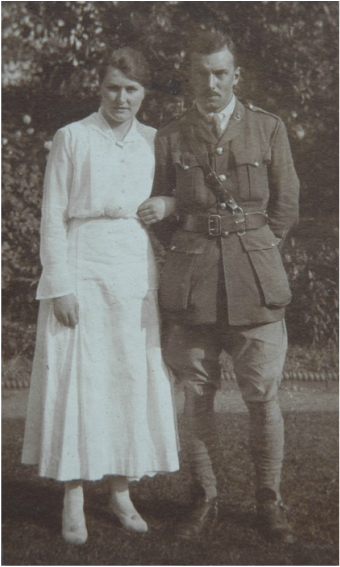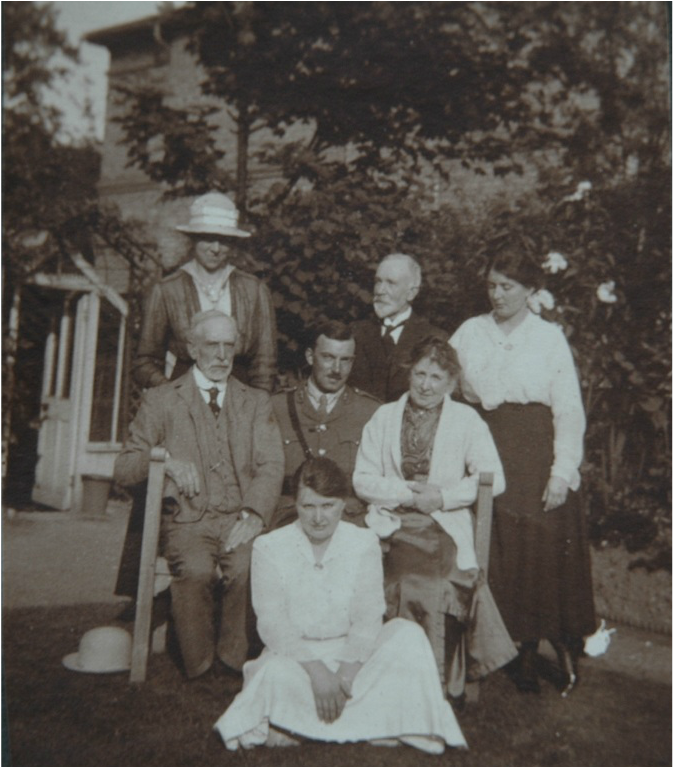George Edward Lines:
Box Farmer and International Toymaker John Lines December 2016 Photos courtesy John Lines
Box Farmer and International Toymaker John Lines December 2016 Photos courtesy John Lines
Who has not heard of Tri-ang Toys and their brands Hornby, Meccano and Dinky, which were the must-have Christmas gifts for children in the 1950s and 1960s? But not many know that George Edward Lines, one of the Lines family, lived in Box after the
First World War. His grandson, John Lines from Edinburgh, has written a website to record George Edward's life at
http://blog.paladyn.org/wp/2016/08/01/george-edward-lines/ and kindly written this article for us.
First World War. His grandson, John Lines from Edinburgh, has written a website to record George Edward's life at
http://blog.paladyn.org/wp/2016/08/01/george-edward-lines/ and kindly written this article for us.
Family of Toymakers
Tri-ang Toys took their name from the family name Lines, where a partnership of three Lines brothers made up the shape of a triangle, whose name was shortened to Tri-ang.
George Edward was one of eight children born to Joseph and Jane (née Fitzhenry) Lines. Joseph and his brother, George, made wooden toys, primarily rocking horses. Joseph and Jane had eight children, of which George Edward was the third son. After the First World War three sons, William, Walter and Arthur Lines but not my grandfather, George Edward, formed Lines Bros Ltd making mechanical, metal toys.
I think one reason he did not follow his other brothers into the family toy business is that the other sons had started Lines Bros in May 1919, whereas their father, Joseph, was continuing to make rocking horses and wooden toys at G&J Lines. Relations between the father and breakaway sons was not amicable, although they came together more after the death of their mother. Perhaps my grandfather didn't wish to be part of the breakaway. Also he had always enjoyed the outdoor life, and I remember him out with the rotavator turning over parts of their large vegetable garden when he was in his 80s; so after the war a change of career must have seemed an ideal opportunity.
Tri-ang Toys took their name from the family name Lines, where a partnership of three Lines brothers made up the shape of a triangle, whose name was shortened to Tri-ang.
George Edward was one of eight children born to Joseph and Jane (née Fitzhenry) Lines. Joseph and his brother, George, made wooden toys, primarily rocking horses. Joseph and Jane had eight children, of which George Edward was the third son. After the First World War three sons, William, Walter and Arthur Lines but not my grandfather, George Edward, formed Lines Bros Ltd making mechanical, metal toys.
I think one reason he did not follow his other brothers into the family toy business is that the other sons had started Lines Bros in May 1919, whereas their father, Joseph, was continuing to make rocking horses and wooden toys at G&J Lines. Relations between the father and breakaway sons was not amicable, although they came together more after the death of their mother. Perhaps my grandfather didn't wish to be part of the breakaway. Also he had always enjoyed the outdoor life, and I remember him out with the rotavator turning over parts of their large vegetable garden when he was in his 80s; so after the war a change of career must have seemed an ideal opportunity.
Some years later, during the Second World War, the company's facilities were converted into making submachine guns and so the company was able to keep its skilled workforce and production facilities running. Manufacture of toys resumed shortly after the war ended. At the peak of their production the company had subsidiaries in over forty countries world-wide and claimed to be the largest toymaker in the world.
Farming at Grove Farm
My grandfather, George Edward Lines did not join the family firm after World War 1; instead he and my grandmother took up farming at Grove Farm, Box Hill. As my grandfather was discharged from the army on 8 April 1919 and married on 19 August 1922 it is quite likely that he and my grandmother moved to the farm sometime between those dates.
Farming at Grove Farm
My grandfather, George Edward Lines did not join the family firm after World War 1; instead he and my grandmother took up farming at Grove Farm, Box Hill. As my grandfather was discharged from the army on 8 April 1919 and married on 19 August 1922 it is quite likely that he and my grandmother moved to the farm sometime between those dates.
|
Grove Farm is a Grade II Listed Building, or more accurately it is two terraced houses on the farm dated from the early 1700s. The farm was owned by the Northey family, lords of the manor, then put up for auction on 24 May 1923, possibly selling (with sitting tenant) to Fred Neate, who owned a considerable amount of land in the area.
It is called Grove House on the auction Sale Particulars map above where the area farmed by George Edward Lines is shown pink, comprising 43 acres, 3 roods, 14 perches, described as Valuable Dairy Farm. The farm house was on three floors with gas and water supplied which appear to have been installed by the tenant (possibly my grandfather). The dairy appears to have been a 6-tie cow-stall. Left: Map of Grove Farm (courtesy Steve Wheeler) |
George Edward Lines (1888 – 1983)
George Edward was born in Islington in 1888 and was an engineer by training. He did an apprenticeship at Clayton and Shuttleworth, traction engine manufacturers in Lincoln, from 1907 to December 1911. Some time between 1911 and 1913 he was in Bristol, where he met the Stevens family, later marrying Doris Joan Stevens, my grandmother.
Before the Great War George Edward went to Germany and Switzerland looking for work there. In December 1913 he wrote a postcard with a picture from Schwartzwald, the Black Forest, Germany, but the stamp is Swiss. He started work at the Swiss Locomotive and Machine Works, a railway equipment manufacturer at Winterthur, Switzerland, some time between August 1913 and May 1914. Shortly after 21 May 1914 he wrote about climbing the Rophaien, near Lucerne, Switzerland and he went on holiday to Bellagio, Lombardy, Italy, some time before July 1914. He was back in England by September 1914, when he joined the army.
George Edward had been an Army reservist for a number of years, so he was called up on the outbreak of the war. He was 26 years old. He had served in the Electrical Engineers from 1904 to 1907 (when he would have been aged 16 to 19). His four year apprenticeship at Clayton & Shuttleworth in Lincoln ended in December 1911, after which he was in the EEREV (I think this is the Electrical Engineers, Royal Engineers, Volunteers) for three years.
George Edward was born in Islington in 1888 and was an engineer by training. He did an apprenticeship at Clayton and Shuttleworth, traction engine manufacturers in Lincoln, from 1907 to December 1911. Some time between 1911 and 1913 he was in Bristol, where he met the Stevens family, later marrying Doris Joan Stevens, my grandmother.
Before the Great War George Edward went to Germany and Switzerland looking for work there. In December 1913 he wrote a postcard with a picture from Schwartzwald, the Black Forest, Germany, but the stamp is Swiss. He started work at the Swiss Locomotive and Machine Works, a railway equipment manufacturer at Winterthur, Switzerland, some time between August 1913 and May 1914. Shortly after 21 May 1914 he wrote about climbing the Rophaien, near Lucerne, Switzerland and he went on holiday to Bellagio, Lombardy, Italy, some time before July 1914. He was back in England by September 1914, when he joined the army.
George Edward had been an Army reservist for a number of years, so he was called up on the outbreak of the war. He was 26 years old. He had served in the Electrical Engineers from 1904 to 1907 (when he would have been aged 16 to 19). His four year apprenticeship at Clayton & Shuttleworth in Lincoln ended in December 1911, after which he was in the EEREV (I think this is the Electrical Engineers, Royal Engineers, Volunteers) for three years.
Service in World War 1
He applied for a temporary commission in the army on the 1 November 1914, at which time he had been serving in the 1st Battalion Fusiliers since 18 September 1914. He was signed off as fit and his medical certificate shows his height at 5ft 7in and his weight 140lb. He was appointed a temporary Second Lieutenant on 8 December 1914.
In February 1915, while training in Chesham, he wrote a charming letter home to his mother, which you can read below, talking of his inoculation against typhoid, and obviously missing home, even though billeted with awfully nice people, the Lowndes family.
He applied for a temporary commission in the army on the 1 November 1914, at which time he had been serving in the 1st Battalion Fusiliers since 18 September 1914. He was signed off as fit and his medical certificate shows his height at 5ft 7in and his weight 140lb. He was appointed a temporary Second Lieutenant on 8 December 1914.
In February 1915, while training in Chesham, he wrote a charming letter home to his mother, which you can read below, talking of his inoculation against typhoid, and obviously missing home, even though billeted with awfully nice people, the Lowndes family.
| george_lines_letter_11_february_1915.pdf | |
| File Size: | 25 kb |
| File Type: | |
He was wounded at Armentières on 9 February 1916, with gunshot wounds to his right foot and right thigh, which rendered him unfit for general service. He spent time at the Royal Artillery & Royal Engineers Convalescent Depot, Ripon, was unfit for any service for three months followed by two months fit for service at home but no route marches. His period of sickness generated a flurry of paperwork, sixteen pieces of which have survived, testimony to the amount of control of lives that the state achieved during and after World War 1. George returned to active duty in August 1916, by which time he had been promoted to Lieutenant.
He was wounded three times in all, though I do not have the details for all of these injuries, and was awarded the Military Cross
for an action in October 1918:[1]
T/Lt (A/Capt) George Edward Lines, RE, attd 497th (Kent) Fd Coy, RE,TF
For great gallantry and determination during operations which led up to the establishment of our line across the Lys on night of 19-20 Oct 1918. He personally supervised the building of infantry bridges across the river under heavy fire, and it was due to his example that the operation was carried to a successful issue.
He was discharged on 4 April 1919 and the back of his medal card shows that his forwarding address at that time was
Grove Farm, Box.
He was wounded three times in all, though I do not have the details for all of these injuries, and was awarded the Military Cross
for an action in October 1918:[1]
T/Lt (A/Capt) George Edward Lines, RE, attd 497th (Kent) Fd Coy, RE,TF
For great gallantry and determination during operations which led up to the establishment of our line across the Lys on night of 19-20 Oct 1918. He personally supervised the building of infantry bridges across the river under heavy fire, and it was due to his example that the operation was carried to a successful issue.
He was discharged on 4 April 1919 and the back of his medal card shows that his forwarding address at that time was
Grove Farm, Box.
|
Farming at Grove Farm
George Edward married Doris Joan Stevens, my grandmother, on 19 August 1922 in Bristol. We can build up some idea of their farming venture at Grove although precise information about the venture is scarce and we don't really know why he didn't follow his other brothers in the family toy business. A family anecdote attributes the problem of naming a range of Tri-ang prams to a visit by the brothers to the farm. Then, in 1922, the problem was solved in a somewhat unlikely manner when Will and Walter visited their brother George at his farm in Gloucestershire (presumably meant to be Wiltshire) where he was trying to raise a herd of pedigree pigs. There and then, amidst all the mud and muck which those animals create, the brothers agreed that "Pedigree" was just the name they had been looking for to describe their beautiful new prams! [2] While at the farm George Edward advertised his eggs, ducks and chickens for sale: Mr Lines selling Pure, Fertile Eggs at 4s per dozen at the farm plus a variety of cockerels, ducks and specialist hens.[3] Mr Lines selling Light Sussex, White Leghorn, Barneveld, Pekin (sic) Drake, White Runners... Inspection Invited.[4] Right: My grandmother and grandfather possibly at their engagement or wedding |
Leaving the Farm
According to family memories, George Edward joined his father in the family business in London in 1923.[5] However I suspect it was later than this as my Uncle Michael, born 16 March 1924, had his birth registered at Chippenham, whereas my father, Roger, born 12 May 1926, was born in Southgate, Middlesex.
The farm, along with the whole village of Box, struggled in the Great Depression after the war, and surely this was a major factor in my grandfather giving up the farming he loved to go and help his father in the toy business. It is also probable that he was influenced by the death of his mother, Jane, on 7 June 1925.
After he moved away from Grove Farm my grandfather still had fond memories of the area, especially the hamlet of Pickwick. A house he rented in Cheam, Surry, was called Pickwick, and later the house he had built in Kingswood had the same name.
Remembering the story that Charles Dickens named The Pickwick Papers, after a coaching family from the hamlet, my uncle and father then named their family newspaper The Pickwick Paper.
I understand that my grandfather's time farming in Box was the happiest time of his life, until a combination of the Depression and a request from his father sent him back to London to work with his father. I believe my uncle Michael was born there (or at least registered in Chippenham) on 16th March 1924. My father was born in Southgate in May 1926, so my grandparents (and Michael) must have moved some time between these dates. After the death of his father George Edward continued to work for Lines Brothers until he retired.
According to family memories, George Edward joined his father in the family business in London in 1923.[5] However I suspect it was later than this as my Uncle Michael, born 16 March 1924, had his birth registered at Chippenham, whereas my father, Roger, born 12 May 1926, was born in Southgate, Middlesex.
The farm, along with the whole village of Box, struggled in the Great Depression after the war, and surely this was a major factor in my grandfather giving up the farming he loved to go and help his father in the toy business. It is also probable that he was influenced by the death of his mother, Jane, on 7 June 1925.
After he moved away from Grove Farm my grandfather still had fond memories of the area, especially the hamlet of Pickwick. A house he rented in Cheam, Surry, was called Pickwick, and later the house he had built in Kingswood had the same name.
Remembering the story that Charles Dickens named The Pickwick Papers, after a coaching family from the hamlet, my uncle and father then named their family newspaper The Pickwick Paper.
I understand that my grandfather's time farming in Box was the happiest time of his life, until a combination of the Depression and a request from his father sent him back to London to work with his father. I believe my uncle Michael was born there (or at least registered in Chippenham) on 16th March 1924. My father was born in Southgate in May 1926, so my grandparents (and Michael) must have moved some time between these dates. After the death of his father George Edward continued to work for Lines Brothers until he retired.
John Lines was born in Edinburgh, and studied Physics at Southampton University. Now retired, he maintain his interests in Science, Open computing, and many other areas. He has been a member of Oxford Phab for a many years, and maintains their web site. You can read more about his family history at: http://blog.paladyn.org/wp/2016/08/01/george-edward-lines/
Family Tree
Joseph Lines (1848 - 1931) married Jane Fitzhenry.
He died 31 December 1931 at 141 Lordship Road, Stoke Newington, Middlesex, leaving £33,543.9s.7d.
Children: William (1879 – 1963); Edith (1880 – 1957); Walter (1882 – 1972); Mary (1883 – 1958); Rosa (1885 – 1889); George Edward (1888 – 1983), my grandfather; Winifred (1890 – 1983); Arthur (1892 – 1962)
George Edward Lines married Doris Joan Stevens in Bristol on 19 August 1922.
They lived in Anne Boleyns Walk, Cheam, Surrey, in 1932. In 1935 they moved into Pickwick, Warren Drive, Kingswood, Surrey, a house they had built, and were still living there in 1957.
Children include: Michael (born 16 March 1924), birth registered at Chippenham; my father, Roger (b 12 May 1926) at Southgate, Middlesex.
Joseph Lines (1848 - 1931) married Jane Fitzhenry.
He died 31 December 1931 at 141 Lordship Road, Stoke Newington, Middlesex, leaving £33,543.9s.7d.
Children: William (1879 – 1963); Edith (1880 – 1957); Walter (1882 – 1972); Mary (1883 – 1958); Rosa (1885 – 1889); George Edward (1888 – 1983), my grandfather; Winifred (1890 – 1983); Arthur (1892 – 1962)
George Edward Lines married Doris Joan Stevens in Bristol on 19 August 1922.
They lived in Anne Boleyns Walk, Cheam, Surrey, in 1932. In 1935 they moved into Pickwick, Warren Drive, Kingswood, Surrey, a house they had built, and were still living there in 1957.
Children include: Michael (born 16 March 1924), birth registered at Chippenham; my father, Roger (b 12 May 1926) at Southgate, Middlesex.
References
[1] Supplement to The London Gazette 4 October 1919, p.12311
[2] Peggy Lines, From G&J to Tri-ang, privately published, p.74
[3] The Bath Chronicle, 27 January 1923
[4] The Bath Chronicle, 15 March 1924
[5] Peggy Lines, From G&J to Tri-ang, p. 106
[1] Supplement to The London Gazette 4 October 1919, p.12311
[2] Peggy Lines, From G&J to Tri-ang, privately published, p.74
[3] The Bath Chronicle, 27 January 1923
[4] The Bath Chronicle, 15 March 1924
[5] Peggy Lines, From G&J to Tri-ang, p. 106
